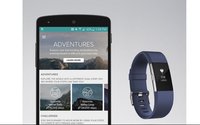 Wearables continue to move toward addressing consumers’ individual needs with new products and services from the connected fitness market leader.
Wearables continue to move toward addressing consumers’ individual needs with new products and services from the connected fitness market leader.
Fitbit this week launched two new
wearables with expanded health and tracking capabilities, as well as a series of complementing motivational challenges on the app side of Fitbit’s ecosystem.
The Fitbit Adventure
Challenges, as they’re called, are virtual tours in the app that guide consumers through remote locations like Yosemite National Park.
Steps taken, or tracked by the wearables, directly
correlate to the consumer’s progress through the virtual experience in the app.
Each ‘adventure’ is based around a predefined path and includes high-quality imagery of the
scenery to immerse consumers in their virtual experience.
advertisement
advertisement
New photos, fun facts, health and fitness tips and mini challenges are unlocked throughout each adventure.
The distance of
each adventure is tailored based on the user’s previous Fitbit data. As a result, the adventures incorporate a degree of difficulty that is challenging, but within reach. That distance
incrementally increases after the user completes each adventure in order to slowly increase daily activity.
The adventures are specifically not positioned to be competitive like previous
offerings, which enable consumers to virtually battle each other for higher fitness metrics through the app.
“Fitbit adventures are the perfect motivation for anyone who may not want to
compete in a traditional Fitbit group challenge with friends or family,” Tim Roberts, executive vice president of interactive at Fitbit, said in a statement.
“These new challenges
inspire you to move more through virtual explorations of some of the most captivating environments in the world.”
Users who participate in in-app challenges move about one mile more per
day than other users, according to Fitbit.
Continued engagement is an issue across the board for wearables. More than half (54%) of consumers who own a wearable discontinue use within three
months of purchase, according to a recent study from Valencell.
This shift toward personalized motivation appears to be occurring across at least a few brands in the wearables space.
For example, Philips’ HealthSuite platform, which hit the market earlier this month, includes a smartwatch and other connected health devices centered around a smartphone app. The app is
designed to adapt to consumers on an individual level based on their current health, lifestyle and goals to help guide them toward improved overall health.
Under Armour’s Connected
Fitness ecosystem, which can also utilize the data from Fitbit devices (as well as other manufacturers), leverages the artificial intelligence capabilities of IBM’s Watson to deliver
contextually relevant coaching recommendations to consumers as they exercise.
Along with the Adventure Challenges, Fitbit incorporated personalized fitness capabilities in its new Charge 2 and
Flex 2 wearables.
The Charge 2 can calculate a user’s personal cardio fitness level based on data from its heart rate sensor, exercise data and the user’s profile in the app.
The Flex 2 is fully waterproof and expands the automatic tracking capabilities to include swimming.
The approach in the fitness and health areas of wearables appears to be expanding from
serving consumers granular data to analyzing the data collected from the devices and serving the significance of that data or, in the case of Under Armour, serving recommendations on next steps to
take based on that significance.
Regardless of the source of the wearable data or how that data is manipulated on the consumer side, it can still be leveraged by marketers and advertisers.